Exploring Discontinued Kohler Bathroom Faucets
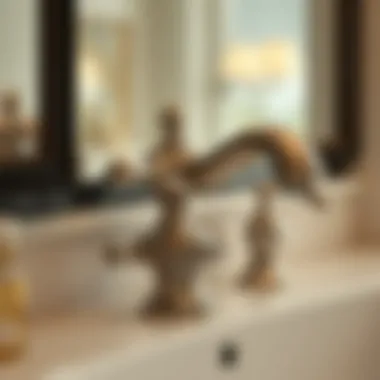
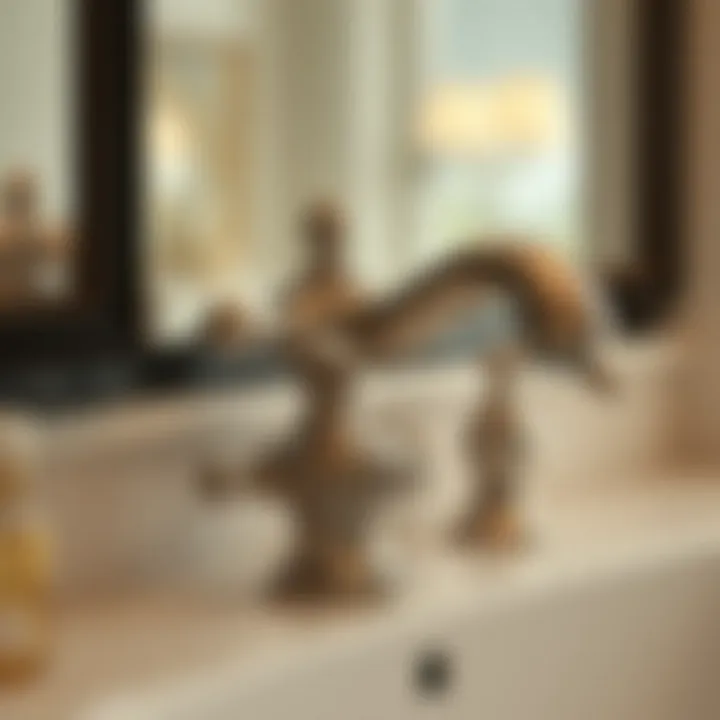
Intro
When it comes to bathroom renovations, one might often overlook the small yet significant details that can make or break the overall aesthetic. Among these details, faucets stand out not just for their function, but for the subtle elegance they can bring to a space. Kohler, a name synonymous with quality and design, has produced a range of bathroom faucets that have graced homes for years. However, as with many manufacturers, some designs have been retired from production, leaving homeowners contemplating their next steps. This article aims to explore the realm of discontinued Kohler bathroom faucets, illuminating their importance in design, implications for those owning these fixtures, and the avenues available for replacement or repair.
Understanding the nuances behind why certain models are phased out can be crucial in making informed choices for future upgrades or restorations. It's more than just a tap; it’s about keeping the spirit of your bathroom intact. For housewives and homeowners alike, navigating through repair options and alternative fixtures can be daunting. Fortunately, this guide presents key insights, discussing potential replacements while considering the long-lasting impact these faucets have on bathroom aesthetics.
Design Inspirations
Trending Styles
Bathroom faucet design has evolved significantly over the decades, showcasing a myriad of trends that echo larger movements in interior design. Each discontinued Kohler faucet carries with it a story—reflecting the style and functionality of its time. For instance, take the popular Perrin & Rowe line, whose intricate detailing and classic charm have often found a place in homes aspiring for timeless elegance. Their departure from production has left homeowners with a gap that is felt both in functionality and beauty.
Two major styles in bathroom faucets, particularly those from Kohler, include:
- Traditional: Characterized by intricate designs, often featuring ornate handles and finishes. Traditional faucets can add a vintage feel to any space.
- Modern: Typically marked by clean lines, minimalistic bodies, and ergonomic designs, modern faucets suit more contemporary homes. Their leave on the market often leads to a scramble for retrofitting older designs.
Color Palettes
In terms of color, Kohler has never shied away from offering a spectrum of choices. Whether it’s the timeless allure of polished chrome or the warm tones of brushed bronze, these faucets play a role in setting a mood within the bathroom. Homeowners may have a fondness for specific finishes like matte black or polished nickel, which were often used in discontinued models. Now that these faucets are no longer available, exploring alternatives that maintain a similar color profile can be essential for keeping the bathroom harmonious.
A few color themes to consider when looking to replace a discontinued Kohler faucet include:
- Neutral Tones: White, gray, or soft earth tones can balance bold design choices.
- Bold Colors: If you wish to make a statement, deep jewel tones or vibrant hues can add flair.
"The right faucet can elevate a bathroom from mundane to magnificent."
As we continue into this guide, we'll delve deeper into product recommendations and other crucial aspects in maintaining the essence of your bathroom.
Prolusion to Discontinued Kohler Bathroom Faucets
When diving into the world of bathroom fixtures, one cannot overlook the significance of Kohler faucets, particularly those that are no longer in production. Discontinued Kohler bathroom faucets serve as a window into design trends, technological innovations, and shifting consumer preferences. Understanding these faucets provides homeowners with insights not just into the products themselves but into the environment and lifestyles that shaped them. This guide addresses why exploring discontinued products matters in the realms of design and home maintenance.
Why Discontinued Faucets Matter
Discontinued models often hold valuable nostalgic elements linked to specific time periods and styles. Such faucets can serve as conversation starters or simply a compelling choice for those wanting to maintain a certain aesthetic in their bathrooms. These fixtures speak volumes about the evolution of home decor and function. For many, using a vintage Kohler faucet isn't just about the fixture; it's about preserving a piece of design history. Recognizing the potential significance in vintage models can augment both personal enjoyment and overall property value.
Understanding the Brand Kohler
Kohler is a name that resonates with quality and style in the realm of bathroom fittings. Founded in 1873, the Kohler Company carved a niche for itself by innovating bathroom equipment that not only served functional purposes but also placed an emphasis on design. Their faucets showcase a balance of durability and aesthetic appeal, making them a favorable choice for many homeowners.
Over the decades, Kohler has adapted to changing market dynamics while maintaining its core values. The brand has introduced various technologies aimed at improving water efficiency and user experience. In doing so, they have won numerous accolades—and more importantly, the trust of consumers worldwide.
A Legacy of Craftsmanship
Kohler faucets are often produced with a focus on sustainability and craftsmanship. This creates a dual purpose: to withstand the test of time while enhancing the environment. When inhabitants of a home choose Kohler, they often feel assurance in the durability and longevity of the products.
Historical Context of Kohler Faucets
To understand the significance of discontinued Kohler bathroom faucets, it is essential to embark on a small journey through history. The evolution of Kohler faucets parallels changing trends in design, technology, and cultural attitudes toward home decor.
From the more utilitarian designs of the early 20th century that primarily focused on functionality to the artful styles adorned in the mid-century modern movements that championed aesthetic simplicity, Kohler has consistently aligned its production with the times.
Pivotal Moments in History
Several watershed moments reflect the adaptability and foresight of Kohler. In the 1980s, for example, environmental awareness began influencing consumer choices, leading to a push for water-saving technologies in taps and showers. Kohler responded accordingly, launching products that prioritize conservation without sacrificing style.
Understanding this historical context enables homeowners and enthusiasts to appreciate the discontinued models better. Knowing when a particular faucet was designed can add depth to its value, whether considering a restoration project or simply wanting to appreciate its past significance.
The Impact of Discontinuation
Understanding the impact of discontinued Kohler bathroom faucets is crucial for homeowners and designers alike. It provides insights into design evolution, market behavior, and the resulting challenges homeowners encounter. Dive into this realm, and you find a rich tapestry of choices and consequences that go beyond mere aesthetic preferences. Discontinuation influences everything from the availability of replacement parts to future property values, representing a shift in both consumer demand and design finesse.
Reasons for Discontinued Models
Market Trends and Demand
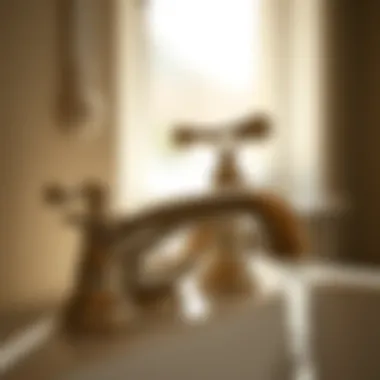
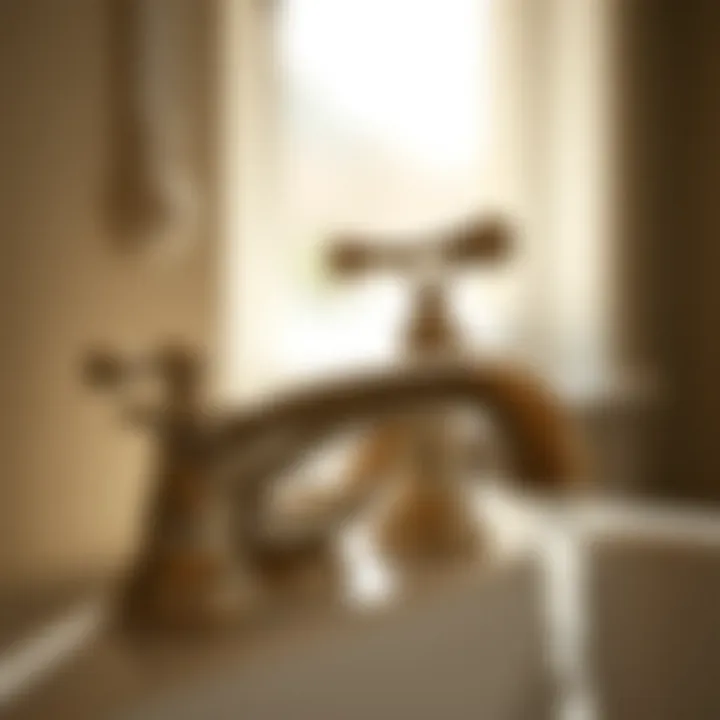
Market trends play a pivotal role in determining which Kohler faucets find a place in the spotlight, and which fade into history. Demand can fluctuate based on numerous factors, including lifestyle shifts, emerging styles, and changing consumer preferences. For instance, homeowners increasingly favor sleek, minimalistic designs that complement modern bathrooms, leaving some older styles in the dust.
This changing landscape leads to discontinuation, particularly of models that no longer resonate with the customer base. A notable aspect of market trends is the increasing interest in sustainable and eco-friendly products. Oftentimes, older faucet models don't comply with newer standards for water conservation, thus becoming less desirable. This emphasizes the importance of staying attuned to current market demands for a successful bathroom renovation.
Technological Advancements
Another driving factor behind the discontinuation of Kohler faucets is the relentless march of technological advancements. As manufacturers introduce innovative features—like touchless operation or advanced filtration systems—older models can quickly become outdated. The rapid improvement in technology means that not only are older models less efficient, they may lack vital functionalities that consumers now expect. For example, faucets that do not incorporate water-saving technology are likely to be viewed unfavorably.
This shift towards more advanced designs highlights the importance of innovation in the fixture market. Homeowners may feel pressured to upgrade to models with modern features, leaving discontinued ones as relics of a past era. Therefore, it's critical for homeowners to recognize the benefits of incorporating technology into their bathroom designs, even if it entails parting ways with beloved faucets.
Shifts in Design Aesthetics
Shifts in design aesthetics impact the types of faucets Kohler produces and subsequently discontinues. The perpetual evolution of what defines beauty and functionality in a bathroom comes from a combination of cultural influences and interior design trends. For instance, vintage and retro styles may once have been popular choices, but contemporary design increasingly embraces clean lines and bold colors.
The increase in design influences from different cultures has also altered consumer preferences—mixing traditional and modern elements is now more commonplace than ever. Homeowners looking to create a unique space may find it difficult to match old models with the latest styles, thus prompting Kohler to phase out certain antique-brushed finishes or ornate designs that no longer align with current tastes. Understanding these shifts can help homeowners navigate their own design pursuits while respecting the past of bathroom aesthetics.
Consequences for Homeowners
Availability of Replacement Parts
One of the biggest challenges homeowners face when dealing with discontinued models is the availability of replacement parts. As manufacturers pivot to new designs, older inventory may dwindle, resulting in a scarcity of essential components. Lack of easily accessible replacement parts can create inconvenience when repairs are needed, leading some to feel trapped in a difficult situation.
Additionally, the increased difficulty in sourcing specific parts can drive repair costs higher, as specialized vendors might command a premium. Families may end up either incurring substantial expenses to find these components or, worse, consider full faucet replacements—prompting unwanted design updates.
Challenges in Matching Existing Fixtures
Matching existing fixtures can often turn into a formidable puzzle for homeowners, especially if they own discontinued Kohler faucets. The struggle to find complementary fixtures can detract from the overall aesthetic cohesion of a bathroom. Brands often update their shades or finishes, meaning that a chosen model from yesteryear may not have a direct match available in newer offerings.
Moreover, when homeowners aim to replace or upgrade faucets, they might discover that their preferred styles are no longer produced. This could lead to a series of compromises, ultimately impacting their design vision and personal expression. Homeowners must strategize well to avoid mixing styles that clash, which can affect the tranquility of their chosen space.
Impact on Property Value
The impact of discontinued fixtures on property value is undeniable. Prospective buyers usually prefer homes that either feature contemporary designs or those that easily facilitate updates. Therefore, outdated fixtures can signal to potential buyers that renovation expenses lie ahead, which may lower the property’s overall value.
Discontinued faucets can also cause buyers to hesitate, worrying about the costly repairs or replacements needed in the future. In contrast, updated bathrooms with modern fixtures can serve as strong selling points, creating compelling reasons for potential buyers to invest. Homeowners should bear these realities in mind when considering the long-term implications of their faucet selection—discontinued models might feel secure now, but their impact can ripple through future real estate endeavors.
Navigating Replacement Options
When dealing with discontinued Kohler bathroom faucets, one crucial element that cannot be overlooked is navigating replacement options. This section aims to shed light on how to approach the task of finding suitable replacements while ensuring that both aesthetics and functionality remain in balance. Whether you're keen on maintaining a harmonious appearance in your bathroom or seeking enhancements in performance, understanding your options is fundamental. This guide will explore ways to identify alternatives and assess their compatibility with existing installations.
Identifying Compatible Alternatives
Brands Offering Similar Styles
In the world of bathroom fixtures, several brands can offer similar styles to Kohler's discontinued lines. Brands like Moen, Delta, and Pfister have collections that echo Kohler's designs, often at competitive price points. A notable characteristic of these brands is their ability to blend classic elegance with modern functionality. For instance, Moen’s sleek design choice often incorporates clean lines, making them a pleasing alternative for homeowners looking to maintain a contemporary vibe in their bathrooms.
Each brand, however, comes with its own set of advantages and drawbacks. Moen's fixtures are widely appreciated for their ergonomic handles and ease of installation, yet users occasionally report challenges regarding their longevity. Picking a brand that mirrors your original Kohler faucet's design can often save a homeowner from additional remodeling costs while providing a comparable aesthetic appeal.
Modern Innovations in Faucet Design
When considering replacement options, it’s worth exploring modern innovations in faucet design. Companies are focusing on enhancing user experience through technology and user-friendly features, which can be a game-changer. A prime example of this innovation is touchless faucets, which utilize motion sensors to operate, maximizing hygiene and convenience. This feature has become increasingly popular due to its ease of use, especially in a family setting.
Moreover, modern designs now often prioritize water conservation. Many contemporary faucets achieve optimal water flow while minimizing wastage, aligning with today’s sustainability goals. The trade-off, however, can sometimes involve higher upfront costs or the need for adjustments in existing plumbing setups.
Custom Solutions for Unique Needs
Not every homeowner has the same requirements or aesthetic preferences, which is exactly where custom solutions become relevant. Seeking a bespoke faucet can be beneficial if standard options don’t meet your needs. There are specialized manufacturers that can craft faucets to specific dimensions, styles, and finishes, allowing you to create a piece that is uniquely yours.
The key characteristic of choosing a custom solution is the level of personalization it affords. Homeowners can dictate every aspect, from the finish to the handle style. This, however, comes at a premium price, often presenting a reality check for budget-conscious buyers. Nonetheless, for those looking to achieve a bathroom that reflects their unique taste, custom solutions provide an avenue to elevate design without compromising on identity.
Assessing Quality and Functionality
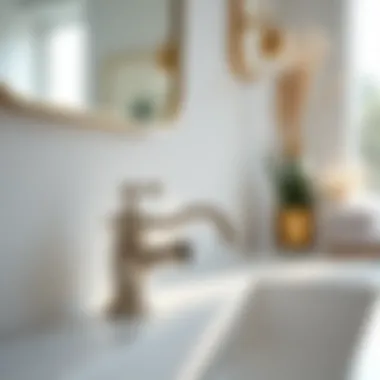
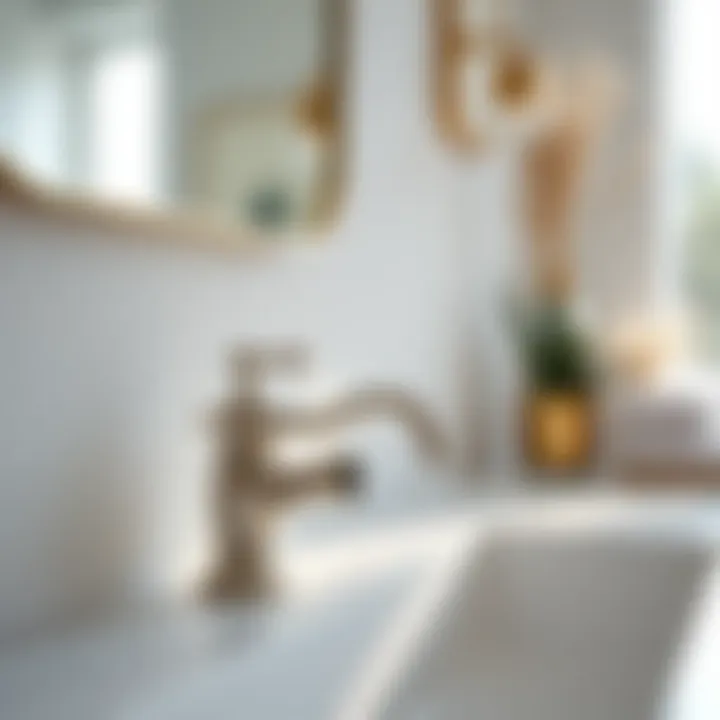
Beyond aesthetic considerations, evaluating quality and functionality stands paramount when selecting a replacement faucet. Understanding performance metrics can ensure that you’re not merely swapping out one fixture for another without considering how well it will serve your household’s needs.
Performance Metrics to Consider
In selecting a replacement faucet, several performance metrics warrant attention. One of the most significant metrics is the flow rate, which determines how much water the faucet dispenses in a given time. A standard flow rate for bathroom faucets hovers around 1.5 to 2.2 gallons per minute. Opting for faucets that meet or exceed this standard can result in better functionality.
Additionally, homeowners should consider durability factors, such as the materials used. Faucets made from brass or stainless steel generally offer longer lifespans compared to those made from plastic components, which may crack or corrode over time. Thus, it's essential to weigh these elements against the faucet's initial cost.
User Reviews and Feedback
User reviews and feedback serve as a valuable resource when assessing potential replacements. The insights shared by others can illuminate not just the positives but also the caveats of specific models. Look for patterns in reviews; repeated mentions of issues like leaks or difficulties in installation might prompt further investigation on your end.
Moreover, platforms like Reddit and home improvement forums can provide unfiltered opinions from fellow homeowners who have experienced the products firsthand. This grassroots feedback can help identify which models are holding their ground in day-to-day use versus those that might be stylish but underperforming.
Warranty and Support Options
Lastly, warranty and support options can make a significant difference in your selection process. Many reputable brands offer warranties that can range from a few years to a lifetime, effectively giving homeowners peace of mind. A solid warranty indicates a company's confidence in their product's durability and often reflects the quality of materials and craftsmanship involved.
Support options should also be evaluated; efficient customer service can be a lifesaver if you encounter issues post-purchase. Brands that offer dedicated support channels, whether through chat, phone, or community forums, demonstrate a commitment to ensuring a satisfying customer experience.
In summary, navigating replacement options for discontinued Kohler bathroom faucets requires careful consideration of aesthetics, functionality, and quality. By digging deep into compatible brands, innovative designs, and user feedback, homeowners can make informed decisions that enhance their bathroom experience.
Design Considerations When Replacing Faucets
When embarking on the journey of replacing bathroom faucets, design considerations play a pivotal role in achieving a harmonious and functional space. While functionality might be the main factor for many, the visual aspect should not be brushed aside. A faucet can be the centerpiece of a bathroom, influencing its overall atmosphere. The choices made here can enhance or detract from the existing design, so weighing the options becomes essential.
Aligning with Overall Bathroom Aesthetics
When you consider faucets, think about how they harmonize with the rest of the bathroom features. It’s not just about picking something shiny off a shelf.
Color Schemes
Color schemes are fundamental in achieving cohesion within a bathroom. Choosing the right colors can evoke a certain mood, whether it be calmness from cool blues or warmth from earthy tones. A neutral faucet color, like chrome or brushed nickel, can blend effortlessly in most color schemes. However, opting for a vibrant color might make a bold statement if that's the desired effect. Remember that mixing too many colors could overwhelm the senses; sticking to a palette that resonates with the overall theme is often seen as a wise choice.
"A well-chosen color can make a room feel larger, smaller, warmer, or cooler."
Material Selection
Material selection goes hand-in-hand with aesthetics and practicality. Common materials include brass, stainless steel, and plastic. Brass faucets often convey a sense of elegance and durability, while stainless steel offers a sleek, modern vibe. Plastic may be more budget-friendly but could lack in longevity and perception of quality. Each material has its unique characteristics, with brass providing timeless appeal and stainless being favored for its resilience. It's essential to weigh these factors alongside design preferences.
Style Coordination
Style coordination involves ensuring that the faucet's design aligns with other elements in the bathroom, such as cabinetry and lighting fixtures. If your bathroom leans towards a traditional style, then a vintage-style faucet would be a natural fit. On the other hand, a minimalist design calls for a sleek, uncomplicated faucet. This can help in avoiding any jarring contrasts that could disrupt the visual flow of the room. An easy maneuver is to assess the overall theme before making a final decision.
Functionality and User Experience
Functionality shouldn't take a back seat to aesthetics. After all, a faucet is meant to be used. How it feels to operate, how efficiently it utilizes water, and whether it includes modern features should all factor into your decision-making process.
Ergonomics of Operation
Ergonomics of operation entails how comfortable and easy a faucet is to use. This means considering lever heights, turning radius, and accessibility. A well-designed faucet should feel intuitive, allowing users to operate it without strain. You want something that fits comfortably in your grip. An ergonomic design can contribute significantly to the user experience, making it less of a hassle during those early morning routines or busy evenings.
Water Efficiency Standards
Water efficiency standards are more than just buzzwords; they have real implications for both the environment and your water bill. Faucets that meet certain standards can significantly reduce water usage without sacrificing performance. Look for models with low flow rates or those certified by the Environmental Protection Agency’s WaterSense program. This not only benefits your budget but also plays a role in conserving a precious resource.
Advanced Features in Modern Faucets
Modern faucets often come packed with advanced features that enhance functionality. Think touchless activation, which is especially handy during cooking or cleaning, or built-in temperature control to prevent scalding. While these features add convenience, they may also come at a higher price point. It's crucial to balance the desired advantages with the budget available for the project. Overall, the right features can greatly improve your daily interactions with the fixture.
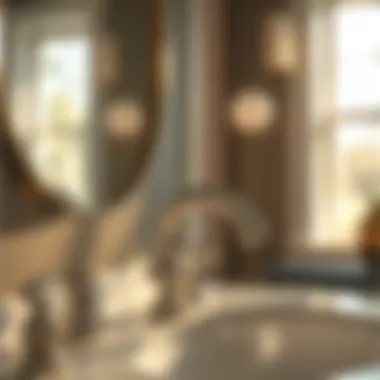
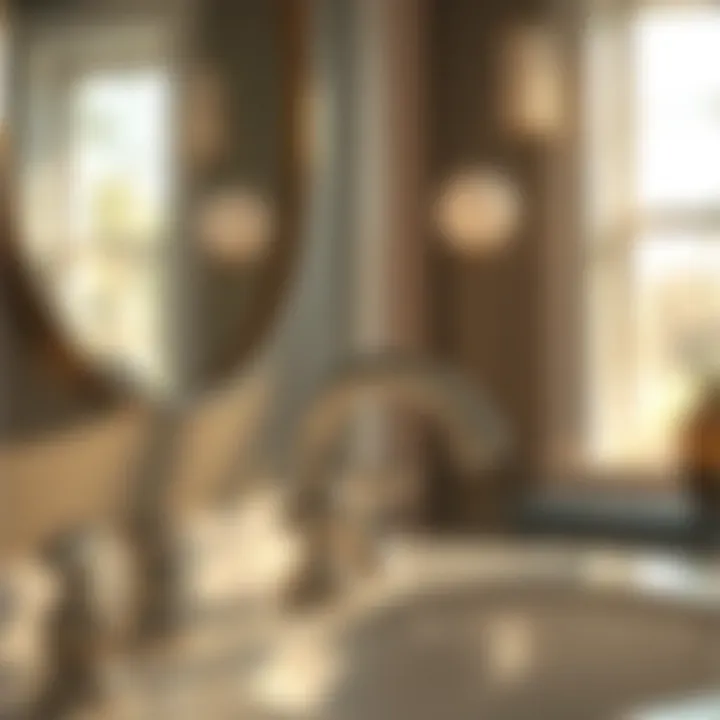
The Restoration of Vintage Faucets
Restoring vintage faucets, especially those from Kohler, can be a labor of love for many homeowners. For enthusiasts, these fixtures are not just plumbing components; they're pieces of history that convey distinct style and craftsmanship. This segment dives deep into the hows and whys of faucet restoration, teasing out its significance for both aesthetics and functionality in our bathrooms.
Evaluating the Feasibility of Restoration
Restoration might seem like a straightforward endeavor. However, it requires a layered understanding that encompasses the faucet's condition, cost implications, and the skill level involved.
Assessing Condition and Damage
A pivotal step in the restoration process is assessing condition and damage. You want to determine if the faucet is merely surface-worn or suffering from deeper issues such as corrosion or mechanical failure. This evaluation plays a crucial role in deciding whether restoration is practical or if a replacement is more sensible.
The key characteristic of assessing condition is the focus on durability. A faucet that just needs cosmetic work might be worth saving, particularly if it's a vintage model that holds sentimental value or aesthetic appeal. On the other hand, significant damage can outweigh the benefits. A well-preserved faucet can enhance the bathroom's charm while maintaining its functionality, making this step crucial.
However, one should also consider the unique feature of age: older faucets may not be designed to meet today's water efficiency standards, presenting an advantage or disadvantage based on how you view modern sustainability practices.
Cost-Benefit Analysis
When investing in restoration, weighing the costs against the benefits is vital. The key characteristic of cost-benefit analysis is that it provides a structured approach to decision-making. Factors include the initial cost of restoration supplies, potential professional fees, and the value these fixtures add to your property.
One advantage of undertaking restoration is in saving a unique piece of design history, something that new models can rarely match. Yet, the analysis might reveal that buying a new, more eco-friendly faucet could ultimately save you money on water bills and repairs down the line.
Thus, comprehensively considering both the tangible and intangible aspects can guide homeowners in making a wise choice that aligns with their needs.
Technical Skills Required
Carrying out a faucet restoration project requires various technical skills. From basic tools for disassembly to knowledge about plumbing fixtures, the key characteristic of this requirement is the range of expertise needed. Basic skills can often suffice for simple restorations, yet more extensive work may necessitate plumbing knowledge, which many homeowners might lack.
One unique feature about technical skills is the learning opportunity they provide; tackling a project aids in skill development, fostering a sense of accomplishment. However, a major disadvantage could arise if the homeowner miscalculates their ability, leading potentially to further issues with water leaks or degradation.
Resources for Restoration Projects
When it comes to restoration, various resources can make the process smoother and more informed. Knowing where to turn for help and information is as vital as understanding the restoration tasks themselves.
Finding Specialized Professionals
Searching for specialized professionals is foundational when undertaking a complex faucet restoration. The key characteristic of working with experts is their know-how; experienced professionals can diagnose problems and restore fixtures to their previous glory in a way that might be beyond the skills of most homeowners.
Many individuals opt for this route because it takes the technical burden off their shoulders, allowing them to focus on the aesthetic choices that matter. However, hiring professionals can come with a significant cost, which should be built into your overall budget.
DIY Restoration Techniques
For the hands-on homeowner, DIY restoration techniques offer a satisfying route. The key characteristic of a DIY approach is empowerment; tackling the project yourself can bring about a profound sense of ownership and connection to the piece. Finding videos and guides specific to the exact model can make the process smoother.
However, there are challenges. It requires time, patience, and sometimes, a willingness to learn through trial and error — not everyone may be cut out for that. Yet, with resources like online forums, one can gather insights and share experiences, making learning a collaborative journey.
Community Resources and Networks
Community resources and networks can be invaluable for anyone delving into faucet restoration. The key characteristic of engaging with a community is the supportive environment; sharing experiences can help homeowners navigate challenges.
Accessing community forums or local meetups connects you with people who have tackled similar projects. They may offer tools or advice that's specific to your area or faucet model. However, sometimes the information found might not always be accurate, which is a potential disadvantage of relying solely on community input.
"Restoration isn’t just a practical task; it's a statement of style, preservation, and sustainability. The choices you make resonate throughout your home, making each fixture a piece of a larger story."
Epilogue and Final Thoughts
Navigating the complex landscape of discontinued Kohler bathroom faucets is not just about addressing immediate plumbing needs; it’s also about understanding the deeper ties between design and functionality in our homes. In this article, we’ve explored how these fixtures, despite being out of production, continue to hold value for homeowners and designers alike.
One of the main takeaways from our discussion is the enduring significance of design. Design is not merely about aesthetics—it's about how a product interacts with its environment and its users. Kohler faucets, known for their elegant styling and dependable functionality, are prime examples of how the right fixture can elevate a bathroom's character. When homeowners face the decision of replacing these fixtures, they often grapple with the desire to honor the original design while blending in more contemporary elements. Therefore, a thoughtful approach toward replacements is essential.
Homeowners benefit from the careful consideration of alternative styles that align with the existing layout and decor. A mismatch between new and old can disrupt the visual harmony of the space. By understanding compatible options, it allows for a seamless integration, ensuring that functionality does not come at the cost of aesthetic appeal.
Furthermore, as the plumbing landscape continuously evolves, there is hope on the horizon for those interested in the future of bathroom fixtures. With emerging technologies and sustainable practices making strides, bathroom fixtures are likely to become more user-friendly and environmentally sound. It’s an exciting time for both homeowners and designers to stay informed and engaged with these trends.
In summary, the journey of exploring discontinued Kohler bathroom faucets teaches us that every fixture in our homes tells a story, intertwining past values with future aspirations. Consider your choices carefully, and embrace the ongoing evolution of bathroom design.
As we look to the future, it’s critical to assess the ongoing needs and preferences in home design. By staying informed, we can appreciate the past while paving the way for our ideal bathrooms.



